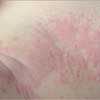Photoclinic: Mycoplasma Infection
A scaly, erysipeloid rash had erupted in the axillae of an 8-year-old boy and spread to the buttocks and thighs within 2 days. The child complained only of pruritus. The rash had worsened despite treatment with clindamycin for 4 days.

A scaly, erysipeloid rash had erupted in the axillae of an 8-year-old boy and spread to the buttocks and thighs within 2 days. The child complained only of pruritus. The rash had worsened despite treatment with clindamycin for 4 days.
The physical examination findings were otherwise unremarkable; the child was afebrile and had no respiratory symptoms. Trimethoprim/sulfamethoxazole was started for suspected methicillin-resistant Staphylococcus aureus infection. Cultures of the skin and throat swab yielded normal findings. The next day, the child was evaluated by a dermatologist who thought the rash was viral; the antibiotic was discontinued. Two days later, the rash had spread to the rest of the child's body; the pruritus had resolved without further intervention, however.
A complete blood cell (CBC) count, erythrocyte sedimentation rate (ESR), and IgM antigen titers and nasopharyngeal culture for Parvovirus, Cytomegalovirus, and Mycoplasma were obtained. The patient was referred to an infectious disease specialist, who also diagnosed a viral exanthema.
High titers of Mycoplasma pneumoniae IgM were detected. The CBC count and ESR were normal; the remainder of the workup was negative for viruses.
M pneumoniae is transmitted through respiratory droplets during close contact. The incubation period averages about 3 weeks. The disease causes a wide variety of clini-cal manifestations in children and adults. These can include otitis media, bullous myringitis, intractable cough, rhinorrhea, and pneumonia of varying severity. Extrapulmonary complications can manifest as hemolysis, joint involvement (eg, arthralgia), nonspecific GI disorders, CNS disorders (eg, aseptic meningitis), or heart disease (eg, rhythm disturbances). Skin disease can range from a mild erythematous maculopapular or vesicular rash--as in this case--to Stevens-Johnson syndrome.
The diagnosis can be confirmed with serological tests for M pneumoniae-specificIgM and IgG titers or with polymerase chain reaction and antigen detection tests.
Macrolides (such as erythromycin, clarithromycin, and azithromycin) are the treatment of choice. For children older than 8 years, tetracycline or doxycycline can also be used. This child's rash resolved after treatment with azithromycin for 5 days.